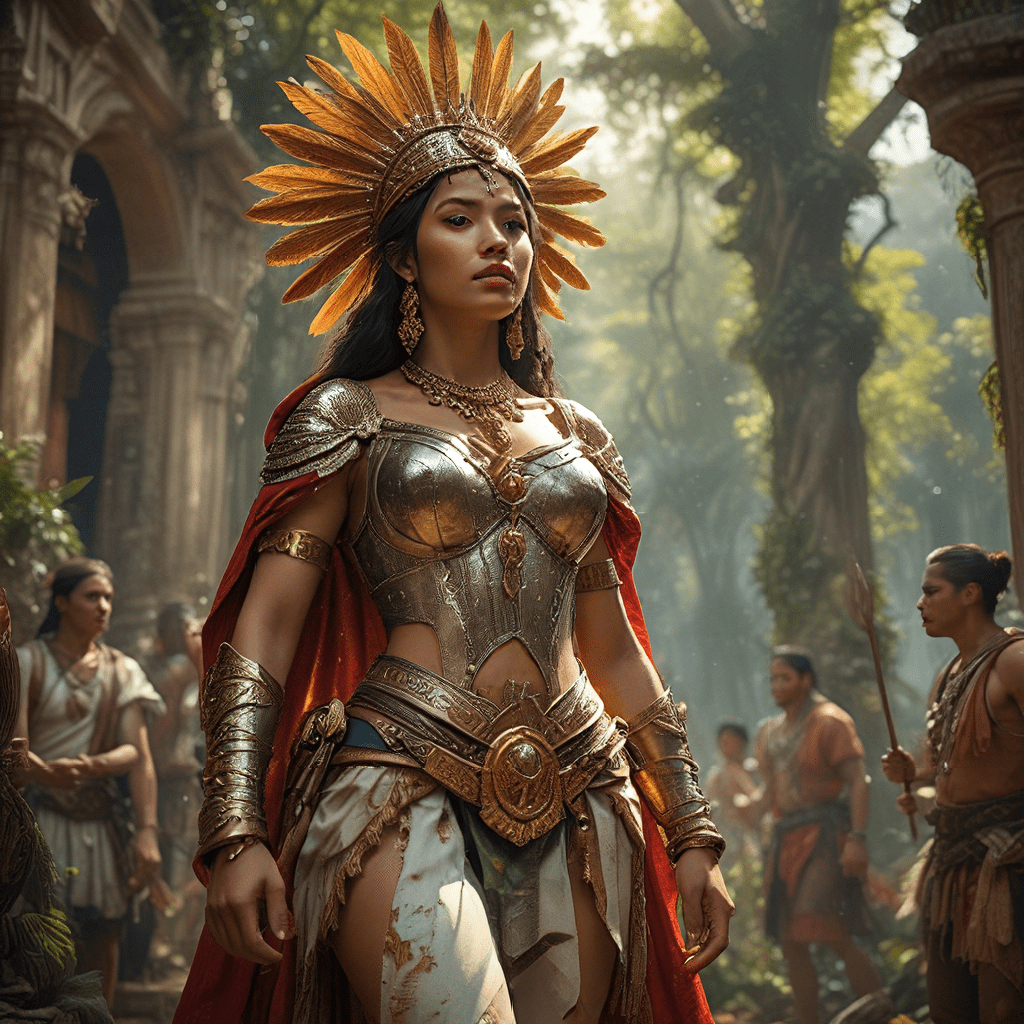Filipino Mythology Before Colonization
The Philippines, a sprawling archipelago in Southeast Asia, boasts a rich tapestry of indigenous beliefs and folklore that pre-dates Spanish colonization. Before the arrival of Europeans, the Filipino people held a deep spiritual connection with nature, believing in a pantheon of deities and spirits that inhabited the natural world.
The ancient Filipinos revered a supreme being, known as Bathala, who held dominion over all creation. In addition to Bathala, a diverse array of lesser gods and goddesses held sway over specific aspects of life, such as agriculture, fertility, and healing. For example, the goddess of rice, "Dian Masalanta", was revered for her role in ensuring bountiful harvests, while "Lalahon", the goddess of childbirth, was sought out for blessings during pregnancy and childbirth.
The animistic beliefs of the Filipinos extended beyond the divine realm, encompassing a vast array of spirits, or "engkanto," that were believed to inhabit mountains, forests, rivers, and seas. The engkanto were often seen as intermediaries between the human world and the divine realm, and their presence was both revered and feared. These spirits were believed to be responsible for various natural phenomena, and their favor was often sought to ensure good fortune. These spirits could be both benevolent and malevolent, depending on their nature and the actions of humans. Stories of interactions with engkanto were passed down through generations, shaping the worldview and cultural identity of the Filipinos.
The Arrival of Spanish Colonization
In the 16th century, the arrival of Spanish colonizers marked a turning point in Filipino history. Driven by a desire to expand their empire and spread Christianity, the Spanish sought to subjugate the indigenous population and impose their own beliefs and practices. The Spanish colonization of the Philippines brought about significant changes in all aspects of Filipino life, including their religious and cultural practices. The Spanish introduced Catholicism, and the practices and beliefs surrounding it, which soon became the dominant religion in the archipelago.
Suppression of Indigenous Beliefs
The Spanish saw the indigenous beliefs of the Filipinos as incompatible with Christianity, and they began to actively suppress these beliefs. Missionaries were sent to convert the Filipinos, and they used a variety of methods to achieve this goal. These methods included the destruction of indigenous temples and shrines, the burning of sacred texts, and the persecution of local spiritual leaders. The Spanish sought to erase any trace of pre-colonial Filipino culture and replace it with their own.
The suppression of indigenous beliefs had a profound impact on Filipino culture. Many traditional practices were lost, and the knowledge of ancient deities and spirits was passed down only orally, making it vulnerable to distortion and loss. The Spanish, however, were aware of the significance of folk beliefs in the lives of the Filipinos and realized that they could not simply be eradicated. Rather, they saw the need to adapt and integrate these beliefs into the framework of Catholicism, to facilitate the conversion of Filipinos.
.
The Role of the Catholic Church
The Catholic Church played a pivotal role in the suppression and subsequent reinterpretation of Filipino mythology. The Spanish missionaries, who were responsible for spreading Christianity, saw the indigenous beliefs as pagan and heretical. To counter the influence of these beliefs, the church actively promoted its own doctrines and practices.
The church used a variety of methods to convert the Filipinos, including the construction of churches and convents, the establishment of schools and hospitals, and the training of local clergy. The Church also engaged in a deliberate strategy of "syncretism," incorporating elements of indigenous beliefs into Catholic practices. This strategy proved effective in facilitating the acceptance of Christianity by the Filipinos, who were able to see the familiar within the new faith.
Syncretism: Blending of Beliefs
In the face of the relentless Spanish campaign to convert the Filipinos, the indigenous beliefs continued to exert a powerful influence on the cultural landscape. With the church unable to completely eradicate these beliefs, they began to adapt and integrate elements of indigenous mythology into Catholic practices. This process of syncretism led to a fascinating blend of beliefs, where ancient deities were reinterpreted as Christian saints or biblical figures, and traditional rituals were imbued with Catholic significance.
For instance, the "anito", the spirits of ancestors revered by the Filipinos, were assimilated into the Catholic concept of "santo," or saints. The veneration of ancestors continued, but it now found a new expression in the worship of Christian saints. The "duwende," mischievous forest spirits, were often associated with the "diablillo", or little devil, in the Catholic belief system. This blending of beliefs blurred the lines between the indigenous and the foreign, creating a unique and hybrid Filipino mythology.
The Influence of Spanish Mythology
While the Spanish sought to eradicate indigenous beliefs, their own mythology also left its mark on Filipino culture. Stories of Spanish saints, demons, and legendary figures found their way into Filipino folklore, often interwoven with indigenous beliefs. The Spanish introduction of the “Legend of the Three Kings,” for example, became a popular story in the Philippines, while the image of the “diablillo” (little devil) was integrated into existing beliefs about mischievous spirits.
The Virgin Mary and the “Maria Clara” Character
One of the most enduring examples of Spanish influence on Filipino mythology is the figure of the Virgin Mary. Devout Catholics in the Philippines revere the Virgin Mary, who is seen as a powerful protector and intercessor. The figure of the Virgin Mary also found its way into Filipino literature, particularly in the novels of Jose Rizal, a national hero. Rizal’s iconic character, “Maria Clara,” embodies idealized Filipino womanhood, characterized by purity, piety, and obedience. Maria Clara’s name, which is a direct reference to the Virgin Mary, signifies the central role of Catholicism in Filipino culture.
The Devil and the “Kapre”
The Spanish introduction of the devil, a central figure in Christian mythology, also had a significant impact on Filipino folklore. The devil often appears in Filipino stories as a powerful and malevolent force, tempting humans to sin and causing misfortune. The concept of the devil resonated with pre-existing beliefs about evil spirits, such as the “kapre,” a giant, cigar-smoking tree spirit known for his mischievous nature and ability to cause harm. The kapre, who was originally associated with local folklore, was often portrayed as a devilish figure in the wake of Spanish colonization.
Modern Interpretations and Reinterpretations
In modern times, Filipino mythology has undergone a period of revival and reinterpretation. Scholars and artists have sought to reclaim and reinterpret indigenous beliefs, recognizing the importance of preserving and celebrating Filipino cultural heritage. Contemporary Filipino writers and filmmakers have explored themes of pre-colonial mythology, weaving traditional beliefs into their narratives. This revival has led to a renewed appreciation for Filipino mythology, as well as a deeper understanding of the enduring influence of Spanish colonization.
The Enduring Influence of Spanish Colonization
The Spanish colonization of the Philippines had a profound impact on Filipino mythology, leading to a complex blending of indigenous beliefs and Spanish influences. While the Spanish sought to eradicate traditional beliefs, they ultimately contributed to the evolution of Filipino folklore. The syncretism of indigenous and Spanish beliefs created a unique and hybrid mythology that continues to shape Filipino culture today. The enduring influence of Spanish colonization can be seen in the reverence for the Virgin Mary, the fear of the devil, and the reinterpretation of ancient figures like the “Kapre.”
FAQ:
Q: What was the biggest effect of Spanish colonization on Filipino mythology?
A: The biggest effect was the blending of indigenous beliefs with Catholic practices, creating a unique and hybrid mythology that continues to shape Filipino culture today.
Q: Did the Spanish completely erase Filipino mythology?
A: No, while the Spanish attempted to suppress indigenous beliefs, they were not entirely successful. Many traditional beliefs and practices survived, often intertwined with Catholic influences.
Q: What is an example of syncretism in Filipino mythology?
A: The "anito," spirits of ancestors revered by the Filipinos, became assimilated into the Catholic concept of "santo," or saints.
Q: How is Filipino mythology being reinterpreted in modern times?
A: Contemporary Filipino writers and filmmakers are exploring themes of pre-colonial mythology, weaving traditional beliefs into their narratives to reclaim and celebrate Filipino cultural heritage.




